Effective Content Promotion: 5 Methods To Do It Without Pissing People Off

I get emails all the time from people asking to contribute to our blog. But I rarely accept or even reply to these offers.
Why? Because the outreach isn’t always as win-win as it seems.
In fact, it’s downright spammy and my team and I simply don’t have time to burn!
Every once in awhile though, I do see a successful outreach program in action.
For instance, I had a consultant blogger reach out to me who did a lot of SEO. He mentioned that we had a broken link in our email list-building article (which we’ve since fixed).
He said:
“Hey, did you know this link is broken? I just wanted to let you know. By the way, I have a resource you can put in your article if you want. I think you’ll agree it’s even better than what was there before. And I know you’re busy so I’ll even write the text for you so you can just copy and paste it in.”
This potential client even included a sentence or two that I could copy and paste so I didn’t have to think about what to write.
In this case, his outreach offer worked.
I ended up replacing the broken link with his link and adding his entry to our list. We wound up talking, too, and I asked, “How do you do this kind of outreach? Has this worked well for you?”
I was interested because I personally thought this form of outreach was win-win. He helped us fix a broken link on our site, and we linked to a piece of content he wanted to promote.
This got me thinking. How do you go about doing content promotion for your small business in a way that’s sustainable and won’t piss people off?
If you’re going around asking for links, aggressively pushing your content at influencers and begging for them to share it, it’s not going to work out well for you.
So what does work? Which practices are sustainable for content promotion?
I’m glad you asked. Read on.
Method #1: Repurposing Content
How It’s a Win-Win: Say you wrote a great blog post. It attracted a lot of traffic to your website, maybe more than any other article before it.
To generate more traffic, you decide to resurrect the post. It’s evergreen, so you’re not worried about content.
But you are concerned that your audience will remember the post and feel like you’re spamming them.
By repurposing your content, you’re dressing up your same great thoughts in a new way.
You’re generating more traffic to your site without writing another in-depth blog post (win for you). You’re also delighting your audience because they feel like the content is new (win for them).
How to Promote in a Non-Spammy Way: There’s a lot of ways you can repurpose your content without being spammy. For instance, you can:
- Put your content on slides and publish them on LinkedIn SlideShare.
- Make a video of the content and put it on YouTube or Vimeo.
- Turn the post into an infographic.
- Use the post as a chapter in an eBook.
By taking something your audience has already seen and presenting it in a new way, you pique their interest. They won’t feel like you’re shoving the same content at them and may be more receptive.
According to Noah Kagan, infographics will net you the most shares, followed by list posts, why posts, and what posts.
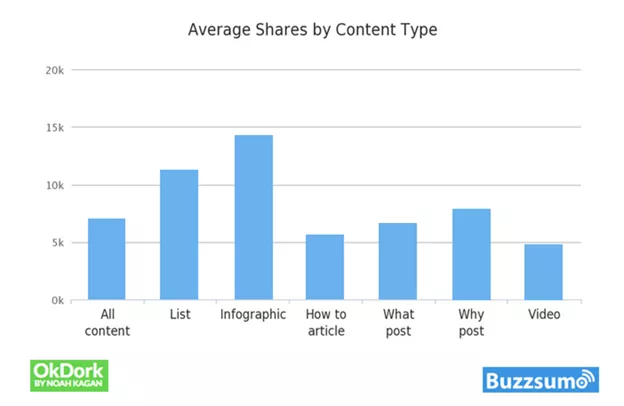
But that doesn’t mean you shouldn’t still experiment with other ways of repurposing your content.
Case Studies/Statistics: Take what Copyblogger did for an example of repurposed content. Their blog post, “The 3-Step Journey of a Remarkable Piece of Content,” has nearly 5,000 shares to date.
The article was first published in June 2014.
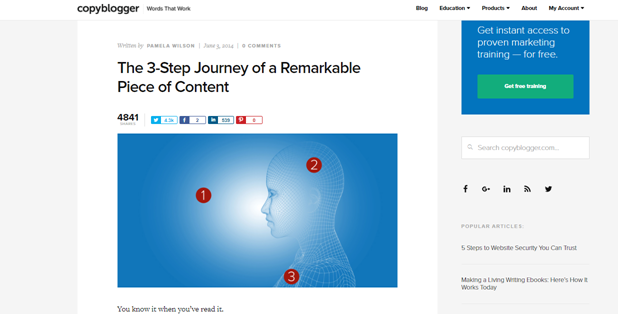
This content generated a lot of traffic. To re-engage their audience, Copyblogger reintroduced the same post, but on SlideShare.
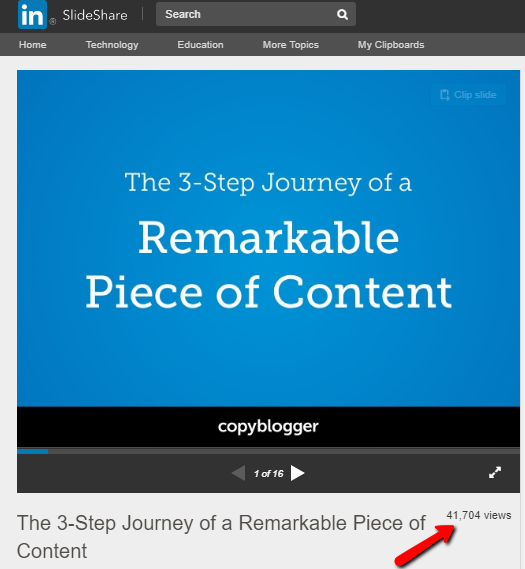
As you can see, it got much of the same reception. To date, the slideshow has 41,700+ views.
Method #2: Broken Backlink Building
How It’s a Win-Win: I mentioned the concept of broken backlink building in the intro of this blog post.
It’s the process of finding broken links on popular sites, recreating the content from those broken links, and offering it up to the webmasters of those sites as a way of getting them to link to you.
Just to reiterate, when that potential client reached out to me, that was one of the only times I paid attention.
Why?
He was solving a problem on the site. Broken links hurt SEO.
This potential client just so happened to provide a better resource and built a rapport with me.
I knew I was talking to a human being and not a bot, which also made me more receptive.
This was a win for him because we gave him the link he wanted, and a win for me, because my link was now fixed, and he was willing to engage and discuss potential longer-term opportunities.
How to Promote in a Non-Spammy Way: The reason I answered this potential client is because of one key difference: value.
The potential client did his homework. He read my post and found something I had missed: the broken link.
He could have told me the link was broken and stopped there. I would have probably read his email but not necessarily replied.
Instead, by offering valuable alternatives, I was receptive. He helped solve a problem for me quickly.
If you decide to reach out to other influencers via broken backlink building, make sure you have an alternative link in mind, too. Make it as easy as possible for the influencer to implement your suggestion into their content.
Case Studies/Statistics: Nikolay Stoyanov’s SEO website NikSto.com practiced broken backlink building in a unique way.
Rather than email sites with broken links directly, Stoyanov made an outreach post listing each site he found with broken links.
He said this was useful in three ways: it corrected the broken link issue for the influencer’s site, it offered him white hat backlinks, and he provided “an additional resource which otherwise was not available anymore.”
Stoyanov did outreach as well, sending emails to each resource in his post. Here’s the template he used.
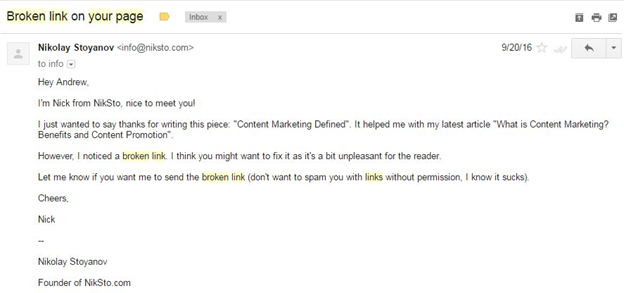
By the end of the day, Stoyanov earned himself 15 links through one piece of content alone.
Method #3: On-Page SEO Strategy
How It’s a Win-Win:
With a solid on-page SEO strategy, you’re making it easier for Google to link-up your content with people searching for answers to their questions online.
The more clear you can make it to search engines what questions you’re answering and/or the specific topic, the more likely they will list your content in response to relevant search queries.
When content aligns with solid SEO keyword research, it’s a win for Google because they serve their users. It’s a win for the user because they get answers, and it’s a win for you because you grow relevant traffic.
How to Promote in a Non-Spammy Way: If you don’t want to come across as spammy, be sure to avoid the SEO practice of keyword stuffing.
As the name suggests, this is when a company squeezes in as many keywords in a piece of content as possible in an ill-fated attempt to elevate their SEO.
Many small business owners are guilty of this — don’t all into the trap.
The copy rarely reads naturally, turning off readers. Google algorithms don’t favor keyword-stuffing either, and those who do it could risk penalization.
To create an on-page SEO strategy, you need to start with proper keyword research for your specific business. Then, implement those keywords in your inbound links from other pages on your site, meta tags, title tags, and other content links to credible sources.
Case Studies/Statistics: Field and Lawn is a UK company that staffs events. The company wanted better on-page SEO, so they turned to copywriting company Brand New Copy to make it happen.
Brand New Copy started with an SEO audit via Screaming Frog SEO Spider. From there, the firm studied Field and Lawn’s best-performing keywords through Google Analytics. Next, they looked at competitor keywords to get a grasp of the market and how they could improve.
By now, Brand New Copy was ready to make changes to the Field and Lawn site. They revised the website copy and included relevant SEO keywords.

This dropped the site bounce rate by 5% and upped year-on-year traffic to 48%.
Method #4: Outreach
How It’s a Win-Win: I’ve already talked about outreach quite a bit, so how is it a win-win?
Let’s say you write a list post of resources that compiles a bunch of marketing blogs. If you reach out to those marketers with a quick note telling them you wrote about them, they are more likely to promote the content.
Why? Because people love to promote what promotes them.
It’s a win-win because your article gets more promotion and the marketers you feature get free publicity.
How to Promote in a Non-Spammy Way: When doing outreach, be sure to offer value up front and make it easy for them to share your content.
Also, you want to highlight the value to the marketer. Don’t bother them with anything that doesn’t directly benefit them.
You can make it easy on them by taking time to craft the exact message you want them to share.
Case Studies/Statistics: UK company liGo Electronics used digital marketing agency Hit Reach to help with their outreach strategy.
liGo produced a guide on maintaining smartphone battery life. Hit Reach then used the following tactics for outreach:
- Earned media or leads; liGo used BuzzStream to generate a cold outreach template (see below)
- Targeted Twitter ads
- StumbleUpon Paid Discovery
- Owned media, including social media profiles, email lists, and blogs
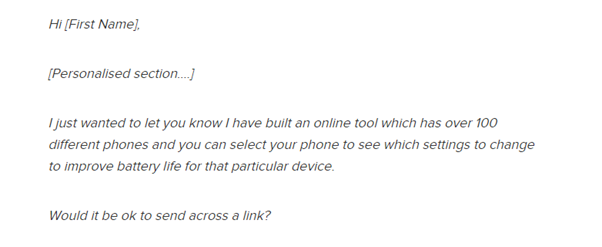
By following the above outreach methods, liGo’s content spread to Lifehacker, Inc., Digg, and even the Daily Mail. Check out their traffic spike below.

Method #5: Guest Posts That Link to Cornerstone Content
How It’s a Win-Win: Cornerstone content is your best-performing content, such as explainers and how-tos. This content should have a great search engine rank and a strong brand voice.
Linking to this content from a guest post on a popular blog is a great way to promote it.
It’s a win-win because you’re providing new content and new ideas to the popular blog’s audience, and you’re also seeing value from it by linking to your own cornerstone content within the post.
How to Promote in a Non-Spammy Way: Linking to cornerstone content within a guest post is one of the least spammy ways of promoting your content, but you have to do it the right way.
First, make sure your guest post is valuable to the blog’s audience. It should represent something new that their audience hasn’t heard before.
Next, make sure to ask for permission from the blog you’re guest posting on to link back to your site’s content.
Finally, make sure that the link you’re suggesting in the guest post is relevant to the reader. The more your link makes sense to include in the post, the more likely the blog will be open to letting you use it.
This method is far less spammy than emailing people with links you want them to share, and it’s more sustainable.
Case Studies/Statistics: As a personal example, I wrote a guest post on how to get more email subscribers for the Leadpages blog. With their permission, I linked back to a cornerstone post I wrote on best sales funnel examples.
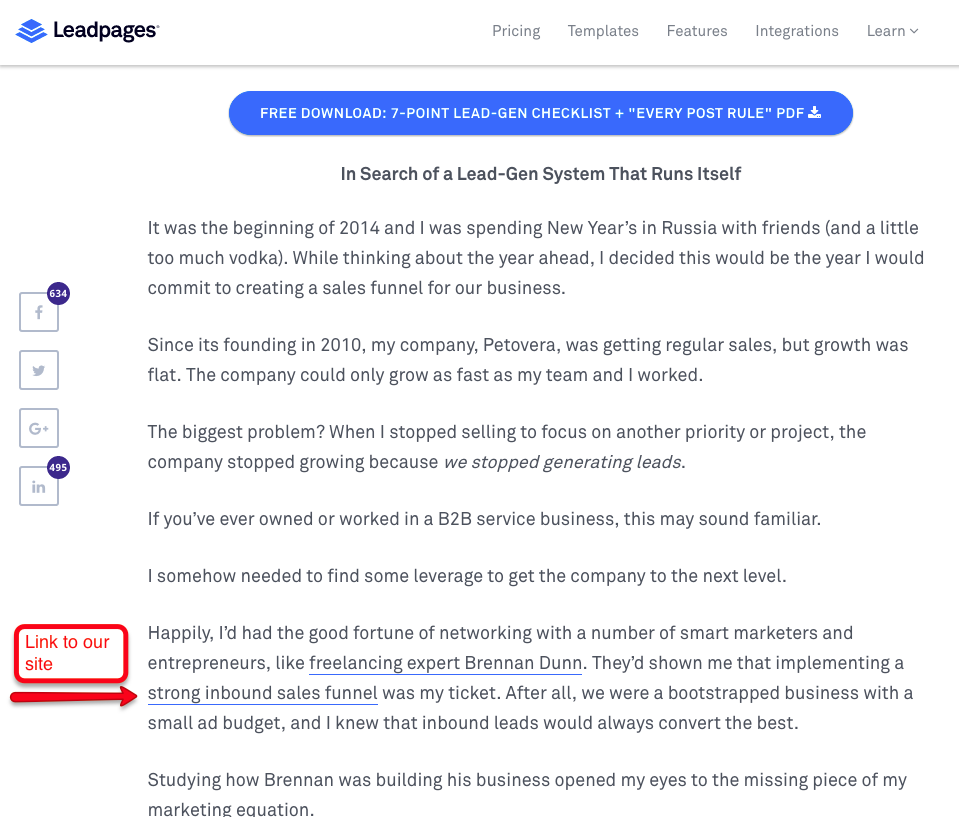
The link to my sales funnel post was relevant to the reader, the topic, and the article on Leadpages.
Our goal with this content promotion strategy was good PR and email list growth.
After this guest post, we added over 500 new subscribers to our email list, and the article has continued to be shared nearly a year later, racking up over 1000 shares on social media.
Since then, we’ve consistently received high-quality client leads that have converted into new accounts for us.
Conclusion
Sharpen your content marketing with my 22-Point Perfect Blog Post Checklist.
In your attempts to get your content out to as many people as possible, you can sometimes piss a few people off.
I’ve been in that position several times. In fact, the only reason I ended up paying attention to an outreach effort was because the prospect sent me links and content to fix a broken link.
Always make sure the content you want to share is an obvious win-win for both of you.
To review:
- By repurposing your content, you can reach new audiences. Repurpose an old blog post as a LinkedIn SlideShare slideshow or a YouTube video.
- Broken backlink building is the process of finding broken links on popular sites, recreating the content from that broken link, and offering your link as the corrected one. It can work, and it’s a great means of outreach for effective content promotion.
- Your on-page SEO strategy will help direct people to your content when they’re searching for it. It starts with keyword research. You should add your keywords to content links, meta tags, and more without keyword stuffing.
- On the note of outreach, if you use a trusted email template, offer value, and make it easy for them to share your content, you’re likely to get responses. People love to promote what promotes them.
- Cornerstone content is your most valuable copy. Link back to it via guest posts on popular sites, but make sure the link makes sense for the reader, and that the site you’re posting on allows it.
Have you accidentally pissed off others with your content promotion? Which of these strategies do you think will serve you best in the future? Let me know in the comments.
Keep Hustlin’, Stay Focused,
—Matt













